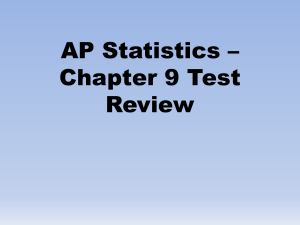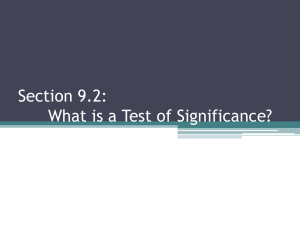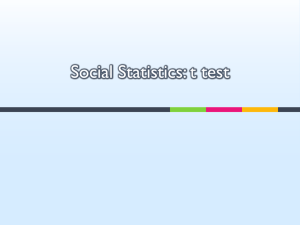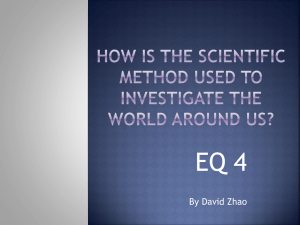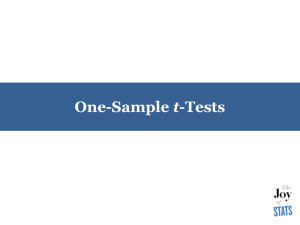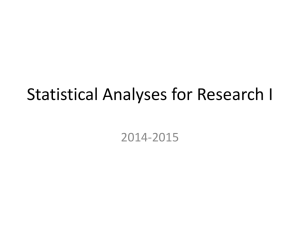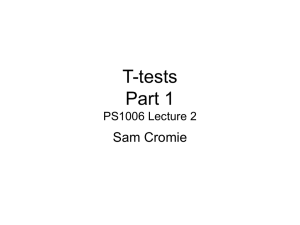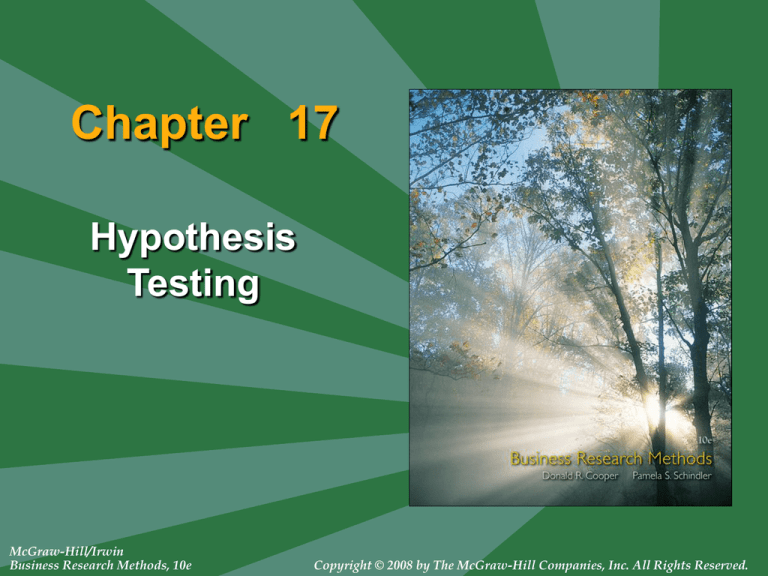
Chapter 17
Hypothesis
Testing
McGraw-Hill/Irwin
Business Research Methods, 10e
Copyright © 2008 by The McGraw-Hill Companies, Inc. All Rights Reserved.
17-2
Learning Objectives
Understand . . .
• The nature and logic of hypothesis testing.
• A statistically significant difference
• The six-step hypothesis testing procedure.
17-3
Learning Objectives
Understand . . .
• The differences between parametric and
nonparametric tests and when to use each.
• The factors that influence the selection of an
appropriate test of statistical significance.
• How to interpret the various test statistics
17-4
Hypothesis Testing Finds Truth
“One finds the truth by making a
hypothesis and comparing the truth to
the hypothesis.”
David Douglass, physicist
University of Rochester
17-5
Hypothesis Testing
Inductive
Reasoning
Deductive
Reasoning
17-6
Statistical Procedures
Inferential
Statistics
Descriptive
Statistics
17-7
Hypothesis Testing
and the Research Process
17-8
When Data Present a Clear Picture
Researchers use
hypothesis testing to
hunt for truth. As
Abacus states in this
ad, when researchers
‘sift through the chaos’
and ‘find what matters’
they experience the “ah
ha!” moment.
17-9
Approaches to Hypothesis Testing
Classical statistics
• Objective view of
probability
• Established
hypothesis is rejected
or fails to be rejected
• Analysis based on
sample data
Bayesian statistics
• Extension of classical
approach
• Analysis based on
sample data
• Also considers
established
subjective probability
estimates
17-10
Statistical Significance
17-11
Types of Hypotheses
• Null
– H0: = 50 mpg
– H0: < 50 mpg
– H0: > 50 mpg
• Alternate
– HA: = 50 mpg
– HA: > 50 mpg
– HA: < 50 mpg
17-12
Two-Tailed Test of Significance
17-13
One-Tailed Test of Significance
17-14
Decision Rule
Take no corrective action if the
analysis shows that one cannot
reject the null hypothesis.
17-15
Statistical Decisions
17-16
Probability of Making a Type I Error
17-17
Critical Values
17-18
Exhibit 17-4 Probability of Making A Type
I Error
17-19
Factors Affecting Probability of
Committing a Error
True value of parameter
Alpha level selected
One or two-tailed test used
Sample standard deviation
Sample size
17-20
Probability of Making A Type II Error
17-21
Statistical Testing Procedures
State null
hypothesis
Interpret the
test
Stages
Obtain critical
test value
Choose
statistical test
Select level of
significance
Compute
difference
value
17-22
Tests of Significance
Parametric
Nonparametric
17-23
Assumptions for Using Parametric Tests
Independent observations
Normal distribution
Equal variances
Interval or ratio scales
17-24
Probability Plot
17-25
Probability Plot
17-26
Probability Plot
17-27
Advantages of Nonparametric Tests
Easy to understand and use
Usable with nominal data
Appropriate for ordinal data
Appropriate for non-normal
population distributions
17-28
How to Select a Test
How many samples are involved?
If two or more samples are involved,
are the individual cases independent or related?
Is the measurement scale
nominal, ordinal, interval, or ratio?
17-29
Recommended Statistical Techniques
Measurement
Scale
Two-Sample Tests
k-Sample Tests
____________________________________________
____________________________________________
Related Samples
Independent
Samples
• Fisher exact test
• x2 two-samples
test
• Cochran Q
• x2 for k samples
• Sign test
• Median test
• Friedman twoway ANOVA
•Wilcoxon
matched-pairs
test
•Mann-Whitney U
•KolmogorovSmirnov
•Wald-Wolfowitz
• Median
extension
•Kruskal-Wallis
one-way ANOVA
• t-test for paired
samples
• t-test
• Repeatedmeasures ANOVA
• One-way
ANOVA
• n-way ANOVA
One-Sample Case
Related Samples
Nominal
• Binomial
• x2 one-sample test
• McNemar
Ordinal
• Kolmogorov-Smirnov
one-sample test
• Runs test
• t-test
Interval and
Ratio
• Z test
Independent
Samples
• Z test
Questions Answered by
One-Sample Tests
• Is there a difference between observed
frequencies and the frequencies we would
expect?
• Is there a difference between observed
and expected proportions?
• Is there a significant difference between
some measures of central tendency and
the population parameter?
17-30
17-31
Parametric Tests
Z-test
t-test
17-32
One-Sample t-Test Example
Null
Ho: = 50 mpg
Statistical test
t-test
Significance level .05, n=100
Calculated value
1.786
Critical test value 1.66
(from Appendix C, Exhibit C-2)
17-33
One Sample Chi-Square Test Example
Intend to
Join
Number
Interviewed
Percent
(no. interviewed/200)
Expected
Frequencies
(percent x 60)
Dorm/fraternity
16
90
45
27
Apartment/rooming
house, nearby
13
40
20
12
Apartment/rooming
house, distant
16
40
20
12
Living Arrangement
Live at home
Total
15
30
15
_____
_____
_____
_____
9
60
200
100
60
17-34
One-Sample Chi-Square Example
Null
Ho: 0 = E
Statistical test
One-sample chi-square
Significance level .05
Calculated value
9.89
Critical test value 7.82
(from Appendix C, Exhibit C-3)
17-35
Two-Sample Parametric Tests
17-36
Two-Sample t-Test Example
A Group
B Group
Average hourly
sales
X1 = $1,500
X2 = $1,300
Standard
deviation
s1 = 225
s2 = 251
17-37
Two-Sample t-Test Example
Null
Ho: A sales = B sales
Statistical test
t-test
Significance level .05 (one-tailed)
Calculated value
1.97, d.f. = 20
Critical test value 1.725
(from Appendix C, Exhibit C-2)
17-38
Two-Sample Nonparametric Tests: Chi-Square
On-the-Job-Accident
Cell Designation
Count
Expected Values
Yes
No
Row Total
Heavy Smoker
1,1
12,
8.24
1,2
4
7.75
16
Moderate
2,1
9
7.73
2,2
6
7.27
15
Nonsmoker
3,1
13
18.03
3,2
22
16.97
35
Column Total
34
32
66
Smoker
17-39
Two-Sample Chi-Square Example
Null
There is no difference in
distribution channel for age
categories.
Statistical test
Chi-square
Significance level .05
Calculated value
6.86, d.f. = 2
Critical test value 5.99
(from Appendix C, Exhibit C-3)
17-40
SPSS Cross-Tab Procedure
17-41
Two-Related-Samples Tests
Parametric
Nonparametric
17-42
Sales Data for Paired-Samples t-Test
Company
GM
GE
Exxon
IBM
Ford
AT&T
Mobil
DuPont
Sears
Amoco
Total
Sales
Year 2
126932
54574
86656
62710
96146
36112
50220
35099
53794
23966
Sales
Year 1
123505
49662
78944
59512
92300
35173
48111
32427
49975
20779
Difference D
3427
4912
7712
3192
3846
939
2109
2632
3819
3187
ΣD = 35781
.
D2
11744329
24127744
59474944
10227204
14971716
881721
4447881
6927424
14584761
10156969
ΣD = 157364693
.
17-43
Paired-Samples t-Test Example
Null
Year 1 sales = Year 2 sales
Statistical test
Paired sample t-test
Significance level .01
Calculated value
6.28, d.f. = 9
Critical test value 3.25
(from Appendix C, Exhibit C-2)
17-44
SPSS Output for Paired-Samples t-Test
17-45
Related Samples Nonparametric Tests:
McNemar Test
Before
After
Do Not Favor
After
Favor
Favor
A
B
Do Not Favor
C
D
17-46
Related Samples Nonparametric Tests:
McNemar Test
Before
After
Do Not Favor
After
Favor
Favor
A=10
B=90
Do Not Favor
C=60
D=40
17-47
k-Independent-Samples Tests: ANOVA
• Tests the null hypothesis that the means of
three or more populations are equal
• One-way: Uses a single-factor, fixedeffects model to compare the effects of a
treatment or factor on a continuous
dependent variable
17-48
ANOVA Example
__________________________________________Model Summary_________________________________________
Source
d.f.
Sum of Squares
Mean Square
F Value
p Value
Model (airline)
2
11644.033
5822.017
28.304
0.0001
Residual (error)
57
11724.550
205.694
59
23368.583
Total
_______________________Means Table________________________
Count
Mean
Std. Dev.
Std. Error
Lufthansa
20
38.950
14.006
3.132
Malaysia Airlines
20
58.900
15.089
3.374
Cathay Pacific
20
72.900
13.902
3.108
All data are hypothetical
17-49
ANOVA Example Continued
Null
A1 = A2 = A3
Statistical test
ANOVA and F ratio
Significance level .05
Calculated value
28.304, d.f. = 2, 57
Critical test value 3.16
(from Appendix C, Exhibit C-9)
17-50
Post Hoc: Scheffe’s S Multiple Comparison
Procedure
Verses
Lufthansa Malaysia
Airlines
Malaysia
Airlines
Diff
Crit.
Diff.
p Value
19,950
11.400
.0002
Cathay
Pacific
33.950
11.400
.0001
Cathay
Pacific
14.000
11.400
.0122
17-51
Multiple Comparison Procedures
Test
Complex
Comparisons
Pairwise
Comparisons
Equal
n’s
Only
Unequal
n’s
Equal
Variances
Assumed
X
X
Unequal
Variances
Not
Assumed
Fisher LSD
X
Bonferroni
X
X
Tukey HSD
X
X
Tukey-Kramer
X
X
Games-Howell
X
X
X
Tamhane T2
X
X
X
X
X
Scheffé S
X
X
X
Brown-Forsythe
X
X
X
X
X
X
Newman-Keuls
X
X
Duncan
X
X
Dunnet’s T3
X
Dunnet’s C
X
17-52
ANOVA Plots
Lufthansa Business
Class Lounge
17-53
Two-Way ANOVA Example
__________________________________________Model Summary_________________________________________
Source
d.f.
Sum of Squares
Mean Square
F Value
p Value
Airline
2
11644.033
5822.017
39.178
0.0001
Seat selection
1
3182.817
3182.817
21.418
0.0001
Airline by seat selection
2
517.033
258.517
1.740
0.1853
Residual
54
8024.700
148.606
__________Means Table Effect: Airline by Seat Selection___________
Count
Mean
Std. Dev.
Std. Error
Lufthansa economy
10
35.600
12.140
3.839
Lufthansa business
10
42.300
15.550
4.917
Malaysia Airlines
economy
10
48.500
12.501
3.953
Malaysia Airlines
business
10
69.300
9.166
2.898
Cathay Pacific
economy
10
64.800
13.037
4.123
Cathay Pacific
business
10
81.000
9.603
3.037
All data are hypothetical
17-54
k-Related-Samples Tests
More than two levels in
grouping factor
Observations are matched
Data are interval or ratio
17-55
Repeated-Measures ANOVA Example
__________________________________________________________Model Summary_________________________________________________________
Source
d.f.
Sum of Squares
Mean Square
F Value
p Value
Airline
2
3552735.50
17763.775
67.199
0.0001
Subject (group)
57
15067.650
264.345
Ratings
1
625.633
625.633
14.318
0.0004
Ratings by air.......
2
2061.717
1030.858
23.592
0.0001
Ratings by subj.....
57
2490.650
43.696
___________________________________Means Table by Airline _________________________________________________________________________
Count
Mean
Std. Dev.
Std. Error
Rating 1, Lufthansa
20
38.950
14.006
3.132
Rating 1, Malaysia Airlines
20
58.900
15.089
3.374
Rating 1, Cathay Pacific
20
72.900
13.902
3.108
Rating 2, Lufthansa
20
32.400
8.268
1.849
Rating 2, Malaysia Airlines
20
72.250
10.572
2.364
Rating 2, Cathay Pacific
20
79.800
11.265
2.519
______________________________________Means Table Effect: Ratings_________________________________________________________________
Count
Mean
Std. Dev.
Std. Error
Rating 1
60
56.917
19.902
2.569
Rating 2
60
61.483
23.208
2.996
All data are hypothetical.
17-56
Key Terms
• a priori contrasts
• Alternative hypothesis
• Analysis of variance
(ANOVA
• Bayesian statistics
• Chi-square test
• Classical statistics
• Critical value
• F ratio
• Inferential statistics
• K-independent-samples
tests
• K-related-samples tests
• Level of significance
• Mean square
• Multiple comparison tests
(range tests)
• Nonparametric tests
• Normal probability plot
17-57
Key Terms
• Null hypothesis
• Observed significance
level
• One-sample tests
• One-tailed test
• p value
• Parametric tests
• Power of the test
• Practical significance
•
•
•
•
•
•
•
Region of acceptance
Region of rejection
Statistical significance
t distribution
Trials
t-test
Two-independent-samples
tests
17-58
Key Terms
• Two-related-samples
tests
• Two-tailed test
• Type I error
• Type II error
• Z distribution
• Z test



